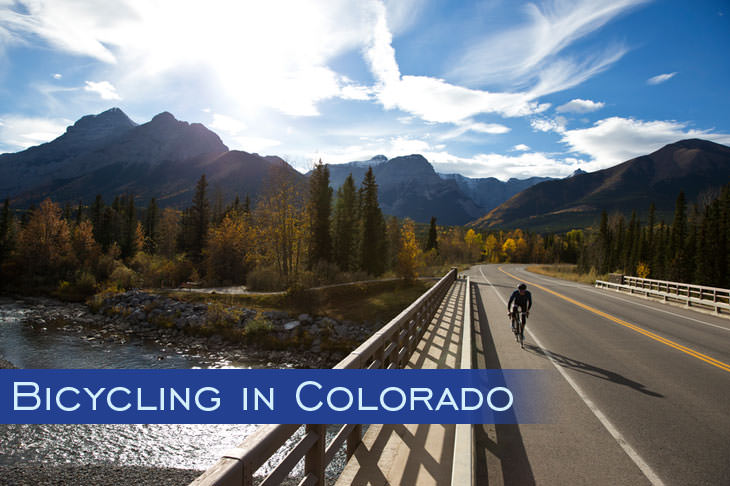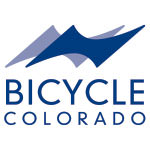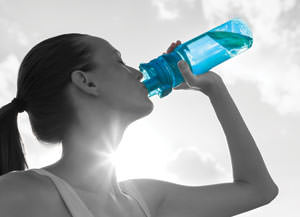victims for over 25 years.
Bicycling in Colorado: Stay Safe Out There
 At my Colorado personal injury law firm, I have helped many injured bicyclists who were the victims of negligent and even aggressive drivers. For the most part, I think Colorado is biker-friendly. Our own governor often bikes to work! But it’s worth discussing issues that can come with bicycling in Colorado.
At my Colorado personal injury law firm, I have helped many injured bicyclists who were the victims of negligent and even aggressive drivers. For the most part, I think Colorado is biker-friendly. Our own governor often bikes to work! But it’s worth discussing issues that can come with bicycling in Colorado.
However, I have heard from biker friends that there are Colorado roads where they often feel threatened simply due to poor road quality, bad transportation planning or, sadly, aggressive drivers. Personally, those are the roads I would avoid if I were a big road biker. One of my friends stopped biking gorgeous Deer Creek Canyon due to heavy traffic and aggressive drivers.
Beautiful Challenges Bicycling in Colorado
But I also respect bikers’ desires to see the same Colorado sites that people in cars want to see. They also have every right take to the roads to challenge themselves on grueling ascents that pay off in heart-pounding descents (within the speed limit). The trick is staying safe when sharing the road with cars.
Case in point: there is a popular road on the Western Slope that is frequented by bikers due to its stunning scenery and challenging terrain. That road also lacks a shoulder for nearly a mile. The Monument Loop near Colorado National Monument, also known as Highway 340, is an iconic Colorado road.
Unfortunately, back in October, 2015, a 58-year-old cyclist was hit by a car on the road and ended up in ICU. The accident caused a firestorm on the Western Slope. This is an excerpt from a story that ran on 11News.
“Sadly I was not surprised,” said cyclist Dan Ford. “There will be more accidents here if they don’t do something.”
“I was devastated because this section of highway has been a concern of ours for a long time as cyclists,” said Kristina Kittelson.
“Over the years, the drivers have gotten really aggressive and distracted on this highway,” said Kittelson. “With no shoulder I’ve actually quit riding the section as many people I know have.”
Easier Said than Done
So, I wondered, why don’t they fix the road? How hard can it be to add a decent shoulder to a road out in the middle of nowhere? Plenty hard, I learned: CDOT’s Tracy Trulove says it’s easier said than done.
“In order to add bike lanes you have to go through much more of a reconstruction project, and the funding just wasn’t there to do that at the time,” said Trulove. “There’s a lot of challenges including right of way in some areas and also drainage. It could be a CDOT right of way or it could be owned by private land users.”
It seems to me that Colorado bicyclists who want to stay safe on the roads need to choose safe roads, and continue advocating for improvements on the unsafe ones. I know that I wouldn’t let my kids ride on a road without a shoulder. The odds are too great that they’ll get hit! When you decide which roads to ride, ask yourself, “Do I truly feel safe on that road?” If the answer is, No, then pick a different route. Who knows, you may find a new fave ride!
To join other bikers and advocate for safer roads, visit BicycleColorado.org. (And see the related story in this newsletter.)
Have questions about this article? Give me a call at 303-388-5304.
“Give a man a fish and feed him for a day. Teach a man to fish and feed him for a lifetime. Teach a man to cycle and he will realize fishing is stupid and boring.”
— Desmond Tutu
Great Denver Nonprofit Organizations and Philanthropists
Bicycle Colorado
 Bicycle Colorado is a busy nonprofit working to make our state one of the most bicycle-friendly in the nation. The organization encourages and promotes bicycling, increased safety, improved conditions and also provides a voice for people who ride bicycles in Colorado. With the support of its members, the organization has made significant strides in improving the Colorado bicycling experience since 1992.
Bicycle Colorado is a busy nonprofit working to make our state one of the most bicycle-friendly in the nation. The organization encourages and promotes bicycling, increased safety, improved conditions and also provides a voice for people who ride bicycles in Colorado. With the support of its members, the organization has made significant strides in improving the Colorado bicycling experience since 1992.
Here is a list of the organization’s accomplishments:
- Gained hundreds of miles of new shoulders for riding bicycles on state roads.
- Changed the law to allow side-by-side riding when it’s safe to do so.
- Changed the law to require drivers to give bicyclists 3 feet when passing and allows cars to cross a double-yellow line to safely pass.
- Changed the law so people riding bicycles can signal right turns with their right hands and so they can ride through a crosswalk instead of dismounting.
- Protected and improved important mountain bike trails, and ensured mountain biker representation in planning and preserving open space.
- Ended bicycle bans around the state, including bans on riding bikes on specific roads, on racing events and even on bringing your bike on light rail trains.
- Taught more than 70,000 Colorado kids to safely ride their bikes and walk to school, and hundreds of adults how to safely commute to work (and use their bikes for errands and nearby trips).
Bicycle Colorado is a fantastic organization helping to keep our state biker-friendly. Visit their website to learn about membership, biking events and other advocacy issues they’re tackling.
303-417-1544 • info@bicyclecolorado.org
Seven Tips and Tools to Help You Recover from Your Workouts
 All this talk about biking is making me tired! Let’s talk about post-workout routines that can help you properly recover from physical exercise.
All this talk about biking is making me tired! Let’s talk about post-workout routines that can help you properly recover from physical exercise.
- Rest Days – One of the most important components of recovery is to make sure that you give your body some down time. That means not exercising every day. This is particularly important if you strength train or perform intense workouts.
- Sleep – Your body’s tissues recover during sleep. Your hormones are balanced during sleep. Sleep is even more important to athletes. In fact, it’s not unusual for a professional or Olympic athlete to get 10 hours of sleep each night.
- Massage – There are a variety of tools that can help you work out sore muscles, get your circulation to those muscles and to reduce tension in your fascia. These tools include foam rollers, therapy balls, and hands-on massage.
- Mobility Work – It’s important to stay flexible and mobile. You can and should stretch post workout. However, there are other mobility exercises that you can do on your down time. Yoga is one option and there are other stretching and mobility programs to consider.
- Fuel Properly – Make sure that you give your body the nutrition that it needs to recover. This often means making sure that you get enough protein for your muscle cells to recover. Additionally, you want to fuel with complex carbohydrates like vegetables and whole grains.
- Hydrate – When you are dehydrated you cannot flush metabolic waste from your body. You’ll stay sore much longer if you’re not properly hydrated.
- Vary Your Workouts – Another important way to help you recover from your workouts is to vary them. For example, if you work on strength training your legs today, it’s a good idea to work on your arms or core the next day.
As always, I’m here to help. If you’ve been injured in a bicycle accident or know someone who has, please contact me today! It’s my mission to help make our Denver streets safer for everyone: cars, motorcycles, pedestrians, and cyclists.
Free Consultation
Search For
Recent Articles
- Traffic Incident in Bear Valley Involves Bicycle and Vehicle, No Serious Injuries
- Possible DUI Incident Reported in Berkeley Neighborhood
- Possible DUI Suspected in Montbello Traffic Incident
- Potential DUI Suspected in Early Morning University Neighborhood Incident
- Motorcycle Accident in Montbello Results in Serious Injury
Categories
- Arvada
- Aurora
- Auto Accident eBook
- Auto Insurance
- Bicycle
- Bicycle/Motorcycle Accidents
- Bodily injury
- Car accidents
- Centennial
- Colorado
- Colorado Legislature
- community
- Denver
- Denver Metro Motor Vehicle Accidents
- distracted driving
- DUI Accidents
- Englewood
- Events
- Flood Insurance
- Fort Collins
- Highlands Ranch
- Hit and Run
- In The News
- insurance companies
- Lakewood
- Littleton
- Marijuana DUI
- Motorcycle Accidents
- Motorcycle Insurance
- Motorcycle Law eBook
- Motorcycles
- Newsletter
- Pedestrian
- Personal Injury Law
- Press Release
- Safe Driving
- Safety
- Scooters
- technology
- Tips
- Uncategorized
- vibrio vulnificus bacteria
- Videos
- Westminster
- Winter Driving
- Wrongful Death
Archive
- August 2025
- July 2025
- June 2025
- May 2025
- April 2025
- March 2025
- February 2025
- January 2025
- December 2024
- November 2024
- October 2024
- September 2024
- August 2024
- July 2024
- May 2024
- April 2024
- March 2024
- February 2024
- January 2024
- December 2023
- November 2023
- October 2023
- September 2023
- August 2023
- July 2023
- June 2023
- May 2023
- April 2023
- March 2023
- February 2023
- January 2023
- November 2022
- September 2022
- April 2022
- March 2022
- February 2022
- January 2022
- December 2021
- November 2021
- October 2021
- September 2021
- August 2021
- July 2021
- June 2021
- May 2021
- April 2021
- January 2021
- December 2020
- November 2020
- October 2020
- September 2020
- August 2020
- July 2020
- June 2020
- May 2020
- April 2020
- March 2020
- February 2020
- January 2020
- December 2019
- November 2019
- October 2019
- September 2019
- August 2019
- July 2019
- June 2019
- May 2019
- March 2019
- February 2019
- January 2019
- December 2018
- November 2018
- October 2018
- September 2018
- August 2018
- July 2018
- June 2018
- May 2018
- April 2018
- March 2018
- February 2018
- January 2018
- December 2017
- November 2017
- October 2017
- September 2017
- August 2017
- July 2017
- June 2017
- May 2017
- April 2017
- March 2017
- February 2017
- January 2017
- December 2016
- November 2016
- October 2016
- September 2016
- August 2016
- July 2016
- June 2016
- May 2016
- April 2016
- March 2016
- February 2016
- January 2016
- December 2015
- November 2015
- October 2015
- September 2015
- August 2015
- July 2015
- June 2015
- May 2015
- April 2015
- February 2015
- November 2014
- October 2014
- September 2014
- July 2014
- June 2014
- May 2014
- April 2014
- March 2014
- February 2014
- January 2014
- October 2012
- September 2012
- August 2012
- July 2012
- February 2012
- March 2011
- October 2010